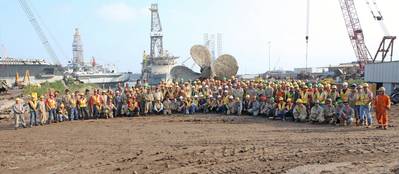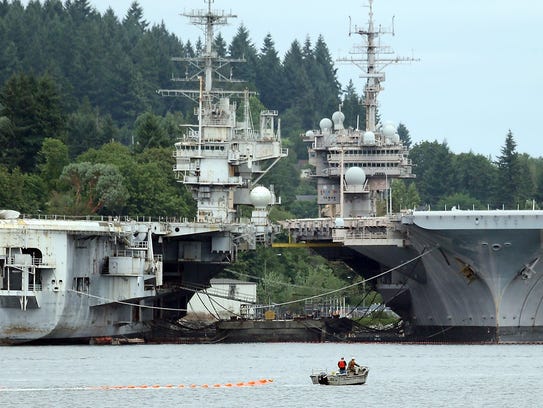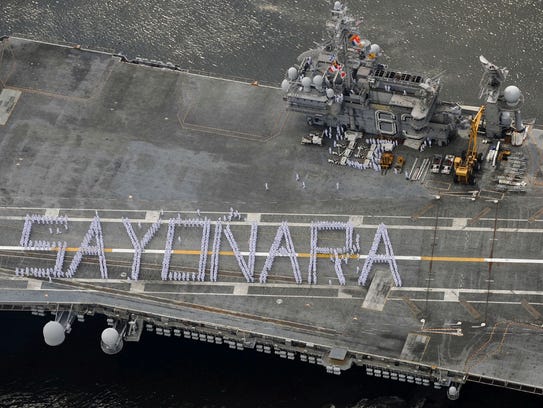When the USS Kitty Hawk
Veterans Association held a reunion in Nashville at the end of October, one
thing was on everyone's mind: The ship was going to scrapped despite years of
efforts and fundraising to turn the aircraft carrier into a museum.
Naval Sea Systems Command
spokeswoman Colleen O'Rourke told the Kitsap Sun in October the Kitty Hawk was
headed for the scrapyard after years of being held in reserve status at the
Inactive Ship Maintenance Facility in Bremerton. This was the Navy's plan all
along, ever since the ship was decommissioned in 2009, although it had not yet
been officially announced until that point.
The former Kitty Hawk
sailors felt blindsided by the news.
They had previously believed
they would at least get a chance to save the aircraft carrier from the fate of
being towed to the scrapyard, which is what happened to the last three inactive
aircraft carriers moored in Bremerton.
The association thought it
was only "a matter of time" for the Kitty Hawk's fate to be decided
after the newest nuclear-powered aircraft carrier, the USS Gerald R. Ford,
joined the fleet on July 22, said Jason Chudy, USS Kitty Hawk Veterans
Association membership coordinator and webmaster.
But by the time the ship was
stricken from the Naval Vessel Register on Oct. 20 following the Ford's
commissioning, the Navy had already long since already decided the ship's fate.
It is unlikely that decision
will change, said Navy Office of Information spokesman Lt. Seth Clarke.
"Per current Navy
policy, only those vessels that are pending decommissioning and determined to
be historically significant or have a high probability of donation are
considered for donation," Clarke said.
Clarke said the Navy is not
required to make ships available for donation.
The Navy can dispose of
ships in a variety of methods, including scrapping them, releasing them to be
turned into museums, selling them to foreign nations, transferring them to
another government agency or using them as target practice.
The method of a ship's
disposal is determined through a complex process. The Chief of Naval Operations
and the Secretary of the Navy ultimately decide which method is the "most
advantageous to the U.S. Navy," Clarke said.
Chudy said the Kitty Hawk
veterans believed the ship would become available for donation after the Ford
joined fleet, and then they would be able to submit an application to obtain
the ship to turn it into a museum.
"We were patiently
looking for that," Chudy said.
But "then boom, instead
being of released, it's going to scrap," said USS Kitty Hawk Veterans
Association President Jim Melka.
Since 2001, when the
associated decided to pursue making the Kitty Hawk into a museum, the
organization has raised more than $5 million of donation pledges, Melka said.
"It came as a very big
surprise," Chudy said. "We'd seen nothing, heard nothing leading up
to this decision. We didn't hear anything from them about scrapping."
Melka heard the news about
the ship's fate when he received a phone call at 10 o'clock the night before
the reunion.
"It was
devastating," he said.
The next day, Melka had to
break the news to the former Kitty Hawk sailors who gathered in Nashville for
the reunion.
"It was
heartbreaking," Melka said. "I had to explain to them what happened
and we didn't have any answers."
Some of the ship's original
crew members were in tears when they heard the news, Melka said.
Melka, who served aboard the
aircraft carrier from 1965 to 1967, said he grew up on the Kitty Hawk.
"I was 17 years old. I
got off just before I turned 21. It was a great ship. I learned a lot. I grew a
lot. I just had a good time while I was on the ship," Melka said.
For former Kitty Hawk sailor
Chudy, who served aboard from 2006 through the ship's decommissioning in 2009,
the news was all too familiar.
"It was kind of a
double whammy as a former Independence sailor, which was last ship to be towed
to Brownsville," Chudy said. "It's disheartening to know the same
thing is what's happening to the Kitty Hawk."
The Kitty Hawk vets aren't
planning on giving up on the ship quite yet. The association is encouraging
"all former crew members, friends and family, really anyone who has an
interest in seeing this historic ship turned into museum," to write to their
representatives in Congress and Navy officials, Chudy said.
"We understand that it
might be a losing battle, but we don't want to give up without a fight,"
Chudy said. "We'll put our blood sweat tears into effort to save ship.
Once every avenue has been exhausted, we'll move on from there."
If the association is unable
to turn the Kitty Hawk itself into a museum, Melka and Chudy said the veterans
would consider building a land-based museum.
"There are no Forrestal
or Kitty Hawk carriers left." Chudy said. "Most have been scrapped or
sunk. We can't let these ships fade into history."
Some of the Kitty Hawk's
notable moments in history include tests to determine aircraft carrier
suitability for the U2 high-altitude reconnaissance planes in 1963 and the
ship's collision with a Russian submarine in the Tsushima Strait in the Sea of
Japan in 1984.
A race riot aboard the Kitty
Hawk in 1972 that ended with almost 60 injured men "initiated reforms in
the Navy culture," according to the ship's history.
During the ship's active
service, the Kitty Hawk participated in combat operations during wars in
Vietnam, Afghanistan and Iraq. The Kitty Hawk was the fleet's only permanently
forward-deployed carrier in Yokosuka, Japan, from 1998 to 2008.
The Kitty Hawk was the last
active service navy aircraft carrier to be powered by an oil-fired steam plant.
Today, all 11 active service aircraft carriers are nuclear-powered. Those ships
will likely never be turned into a museum because they are torn-up too much
when the reactor is taken out of them during the decommissioning process.
"There's none better
than the Kitty Hawk for this honor. Kitty Hawk is the only Cold War era carrier
left to be turned into the museum," Chudy said. Since it's unlikely the
newer classes of nuclear-powered ships will be released to be turned into
museums, "It's the last hope."
Five former aircraft
carriers have been turned into museums. The USS Midway, which served from 1945
to 1992, was the last aircraft carrier turned into a museum in San Diego,
California.
There are currently no other
aircraft carriers available for donation hold. Chief of Naval Operations Adm.
John Richardson decided to re-designated the former USS John F. Kennedy from
being eligible for donation hold on Sept. 26, to be dismantled as well,
according to Navy spokesman Clarke.
Clarke said Adm. Richardson
made this decision due to the "lack of a viable donation
application," since the ship was first made available for donation in
2009.
The former Kennedy's page on
the Naval Vessel Register has not yet been updated to reflect this decision.
To date, the Navy has
donated 48 vessels to be used as museums and memorials across the country to
various non-profit organizations and states.
Source:
kitsap
sun. 28 November 2017
http://www.kitsapsun.com/story/news/local/2017/11/28/uss-kitty-hawk-veterans-devastated-aircraft-carrier-headed-scrapyard/836475001/






